Response of Soil Temperature to Soil Moisture Content and Meteorological Elements with Gravel-Sand Mulching
Abstract
:1. Introduction
2. Materials and Methods
2.1. Experimental Site Overview
2.2. Experimental Design
2.3. Measurement Method
2.4. Data Processing
3. Results
3.1. Dynamic Changes in Soil Moisture Content
3.2. Dynamic Changes in Soil Temperature
3.3. Soil Accumulated Temperature
3.4. Characteristics of Soil Temperature Variation with Soil Depth
3.5. Relationship Between Soil Temperature and Soil Moisture Content
3.6. Relationship Between Soil Temperature and Meteorological Factors
3.7. Soil Temperature Gradient
3.8. Relationships Among Soil Temperature, Soil Moisture Content, and the Ratio of Actual to Reference Evapotranspiration (ETa/ET0)
4. Discussion
4.1. Relationship Between Soil Water and Heat Under Gravel–Sand Mulching Conditions
4.2. Relationship Between Meteorological Elements and Soil Temperature Under Gravel–Sand Mulching Conditions
4.3. Characteristics of Soil Thermal Conductivity and Temperature Gradient Under Gravel–Sand Mulching Conditions
5. Conclusions
- (1)
- In the 0–25 cm soil layer under gravel–sand mulching conditions, the soil accumulated temperature is the lowest at 8:00; within the 0–15 cm range, the soil accumulated temperature at 14:00 is greater than at 20:00; and within the 15–25 cm range, the soil accumulated temperature at 14:00 is less than at 20:00.
- (2)
- Within the 0–20 cm soil layer, the soil accumulated temperature tends to decrease with an increase in soil moisture content under gravel–sand mulching conditions but increases the rate of soil temperature variation. The soil thermal conductivity at a 10–15 cm depth under gravel–sand mulching conditions tends to increase with the increase in soil moisture content at a 20–40 cm depth, and the increase in the lower soil moisture content is beneficial for promoting the transfer of temperature in the upper soil layers and eliminating the temperature differences between soil layers.
- (3)
- Under gravel–sand mulching conditions, meteorological factors such as air temperature, evaporation, vapor pressure, and wind speed accelerate the thermal convection process of heat conduction in the atmosphere, and the key meteorological factors affecting soil temperature are air temperature and vapor pressure.
- (4)
- The 10–15 cm layer of soil heat is relatively stable and is the key buffer layer and heat storage pool for soil heat.
Author Contributions
Funding
Data Availability Statement
Conflicts of Interest
References
- Yu, W. Study on the Influence of Sand Mulching on Soil Moisture and Temperature Regularities. Master’s Thesis, Lanzhou University of Technology, Lanzhou, China, 2016. [Google Scholar]
- Liu, Q.; Li, W.; Zhao, G.; Jia, Z.; An, W.; Wang, J.; Mu, M. Effects of Gravel-sand Mulching and Irrigation Amount on Soil Water and Heat and Jujube Fruit Yield in Converted Cropland. J. Agric. Resour. Environ. 2022, 39, 940–947. [Google Scholar]
- Di, Y.; Gao, M.F.; Li, Q.; You, J. Study on the Relationship Between Winter Wheat Canopy Temperature and Soil Moisture Under Different Irrigation Gradients. Chin. Agric. Inf. 2021, 33, 13–23. [Google Scholar]
- Cai, Z.; Duan, L.; Guo, R.; Liu, D. Characteristics of Soil Temperature Variation in Jiangxi Province and Its Relationship with Meteorological Elements. Chin. Agric. Sci. Bull. 2024, 40, 118–125. [Google Scholar]
- Wei, J. Temperature Sensitivity of Soil Organic Matter Decomposition in Forest Soils at Different Altitudes and Its Response to Exogenous Carbon Addition. Master’s Thesis, Anhui Agricultural University, Hefei, China, 2023. [Google Scholar]
- Zhang, Y.; Sun, X.; Guo, X. Study on Diurnal Variation Characteristics of Soil Temperature in Water Conservation Pits under Different Mulching Methods. Water-Sav. Irrig. 2013, 1, 1–5. [Google Scholar]
- Luo, C.; Wang, R.; Wang, L.; Xiong, C.; Wang, X.; Dai, H.; Wan, Q.; Xiao, W. Effects of Different Water and Heat Regulation Methods on Soil Temperature and Root Distribution in Apple-Soybean Intercropping System. J. Soil Water Conserv. 2023, 37, 217–226. [Google Scholar]
- Wang, P.; Yu, A.; Wang, Y.; Su, X.; Chai, J.; Li, Y.; Lv, H.; Shang, Y.; Yang, X. Effects of Post-wheat Green Manure Turning and Reduced Nitrogen Application on Soil Water and Heat Characteristics and Maize Yield. Acta Agron. Sin. 2023, 49, 2793–2805. [Google Scholar]
- Xin, J.; Gao, H.; Shao, M. Effects of Soil Temperature on Soil Water Infiltration. J. Soil Water Conserv. 2009, 23, 217–220. [Google Scholar]
- Zhao, J.; Hong, M.; Ma, Y.; Chen, K. Effects of Different Irrigation Treatments on Soil Temperature of Drip-irrigated Walnut Trees in Arid Areas. Res. Soil Water Conserv. 2019, 26, 327–333. [Google Scholar]
- Ma, Z.; Du, S.; Xue, L. Effects of Different Mulching Methods on Soil Water and Heat Effects and Watermelon Growth in Dry Sandy Fields. Acta Ecol. Sin. 2011, 31, 1295–1302. [Google Scholar]
- Sharmasarkar, F.C.; Sharmasarkar, S.; Miller, S.D.; Vance, G.F.; Zhang, R. Assessment of Drip and Flood Irrigation on Water and Fertilizer Use Efficiencies for Sugarbeets. Agric. Water Manag. 2001, 46, 241–251. [Google Scholar]
- Shen, X.; Zhang, X.; Yao, B.; Li, Q.; Xue, Z.; Dong, J.; Yi, R. Effects of Climate Change on Suitable Sowing Period for Drip-irrigated Peanuts under Mulch in Xinjiang. J. Agric. Eng. 2023, 39, 107–115. [Google Scholar]
- Zhang, T.; Bao, W.; Lei, Q.; Liu, X.; Du, X.; Zhou, J.; Luo, J.; Liu, H. Spatiotemporal Variation Characteristics of Soil Temperature in China from 1951 to 2010 and Its Influencing Factors. Acta Geogr. Sin. 2022, 77, 589–602. [Google Scholar]
- Liu, X. Study on the Characteristics and Influencing Factors of Soil Shallow Temperature Variation in Hohhot Area. For. Surv. Plan. 2023, 48, 46–51. [Google Scholar]
- Liu, Q.; Liu, X.; Wang, L.; Zhao, W.; Ma, J. Soil Water and Heat Characteristics of Alpine Meadow in the Middle Section of Qilian Mountains and Their Response to Meteorological Elements. J. Cent. South Univ. For. Technol. 2023, 43, 156–163. [Google Scholar] [CrossRef]
- Xu, Z.; Liu, S.; Li, X.; Xu, T.; Zhu, Z. 2012 Zhangye Oasis-Desert Region Water, Heat, and Carbon Flux and Meteorological Element Observation Matrix Dataset. China Sci. Data Chin. Engl. Online Ed. 2023, 8, 315–327. [Google Scholar]
- An, K.; Wang, Q.; Wang, W.; Wang, Z.; Chen, L.; Zhang, Z. Spatiotemporal Distribution Law of Soil Temperature in Unsaturated Zone of Arid Areas. South–North Water Transf. Water Sci. Technol. 2015, 13, 70–7383. [Google Scholar]
- Ariyanto, D.P.; Qudsi, Z.A.; Dewi, W.S. The Dynamic Effect of Air Temperature and Air Humidity Toward Soil Temperature in Various Lands Cover at Gunung Bromo, Karanganyar—Indonesia. IOP Conf. Ser. Earth Environ. Sci. 2021, 724, 12003. [Google Scholar] [CrossRef]
- Ren, T.; Jia, Z.; Wang, Z.; Lu, Y.; Liu, X. Characteristics of Soil Temperature Variation Under Plastic Film and Ground Cloth Mulching in Mu Us Desert. Agric. Res. Arid. Areas 2020, 38, 190–199+216. [Google Scholar]
- Tan, J.; Tian, J.; Wang, X.; Li, Y.; Zhao, X. Effects of Different Subsurface Moisture on Water Consumption Rules of Watermelon in Sand Mulching Fields. Agric. Res. Arid. Areas 2014, 32, 94–99. [Google Scholar]
- Tan, J.; Tian, J.; Wang, X.; Zhao, X. Effects of Subsurface Moisture on Growth and Yield of Watermelon in Sand Mulching Fields. Agric. Res. Arid. Areas 2012, 30, 26–31. [Google Scholar]
- Bai, H.; Huang, Y.; Li, L.; Cheng, H. Effects of Temperature and Different Organic Fertilizers on Soil Soluble Organic Matter Content. J. Mt. Agric. Biol. 2012, 31, 103–106. [Google Scholar]
- Yang, H.; He, N.; Li, S.; Yu, G.; Gao, Y.; Wang, R. Effects of Land Use Types on Temperature and Moisture Sensitivity of Soil Organic Matter Mineralization in Subtropical Regions of Southeast China. J. Resour. Ecol. 2016, 7, 85–91. [Google Scholar]
- Ren, Z.; Wang, Z.; Li, W.; Zhang, J.; Yang, W.; Jia, Z.; Li, N. Effects of Different Light Control and Irrigation Amounts on Soil Temperature Variation in Drip-irrigated Corn Fields. Acta Agric. Boreali-Occident. Sinica. J. 2019, 28, 961–971. [Google Scholar]
- Liu, S.; Yang, B.; Lu, L.; Zhang, P.; Lei, L. Soil Water and Heat Characteristics of Dasha Mountain in Guangxi and Their Response to Meteorological Elements. J. Cent. South Univ. For. Technol. 2018, 38, 46–52. [Google Scholar]
- Tang, Z.; He, Z.; Liu, H. Soil Water and Heat Characteristics of Forest-Grass Ecotone in the Middle Section of Qilian Mountains and Their Response to Meteorological Elements. Acta Ecol. Sin. 2012, 32, 52–61. [Google Scholar]
- Guo, Z.; Lu, Y. Diurnal Variation Law of Surface Soil Temperature. Agric. Technol. 2020, 40, 9–11. [Google Scholar]
- Ma, Z.; Wang, W.; Zhang, Z.; Zhao, M.; Chen, L.; Song, H.; Yu, P. Simulation Study on Diurnal Distribution Variation of Soil Water in Shallow Aerated Zone. J. Water Resour. Water Eng. 2019, 30, 245–251. [Google Scholar]
- Cheng, C. Study on Vertical Gradient Variation Characteristics of Secondary Oak Forest Temperature in Kongqing Mountain. Master’s Thesis, Nanjing Forestry University, Nanjing, China, 2017. [Google Scholar]
- Sun, L. Numerical Simulation of Soil Percolation and Pollutant Migration Under Temperature Gradient. Master’s Thesis, Yangzhou University, Yangzhou, China, 2015. [Google Scholar]
- Verhoef, A.; van den Hurk, B.; Jacobs, A.; Heusinkveld, B. Thermal soil properties for vineyard (EFEDA-I) and savanna (HAPEX-Sahel) sites. Agric. For. Meteorol. 1996, 78, 1–18. [Google Scholar]
- Su, Y. Numerical Simulation Study on Soil Heat in Sandy Land; Lanzhou University of Technology: Lanzhou, China, 2020. [Google Scholar]
- Jin, Z.; Wang, X.; Wu, X.; Peng, Y. Test and Analysis of Soil Thermal Parameters and Their Influencing Factors. Rock Soil Mech. 2022, 43, 1335–1340. [Google Scholar]
- Yang, K.; Zhao, B.; Nie, J.; Liu, H. Effects of Wheat Straw Biochar on the Thermophysical Properties of Calcic Soil in Farmland. J. Lanzhou Jiaotong Univ. 2024, 43, 108–113. [Google Scholar]
- Zhang, J.; Gao, Z.; Tong, B.; Wang, L. Research Progress on Soil Temperature Prediction Equations. Acta Pedol. Sin. 2023, 60, 599–609. [Google Scholar]

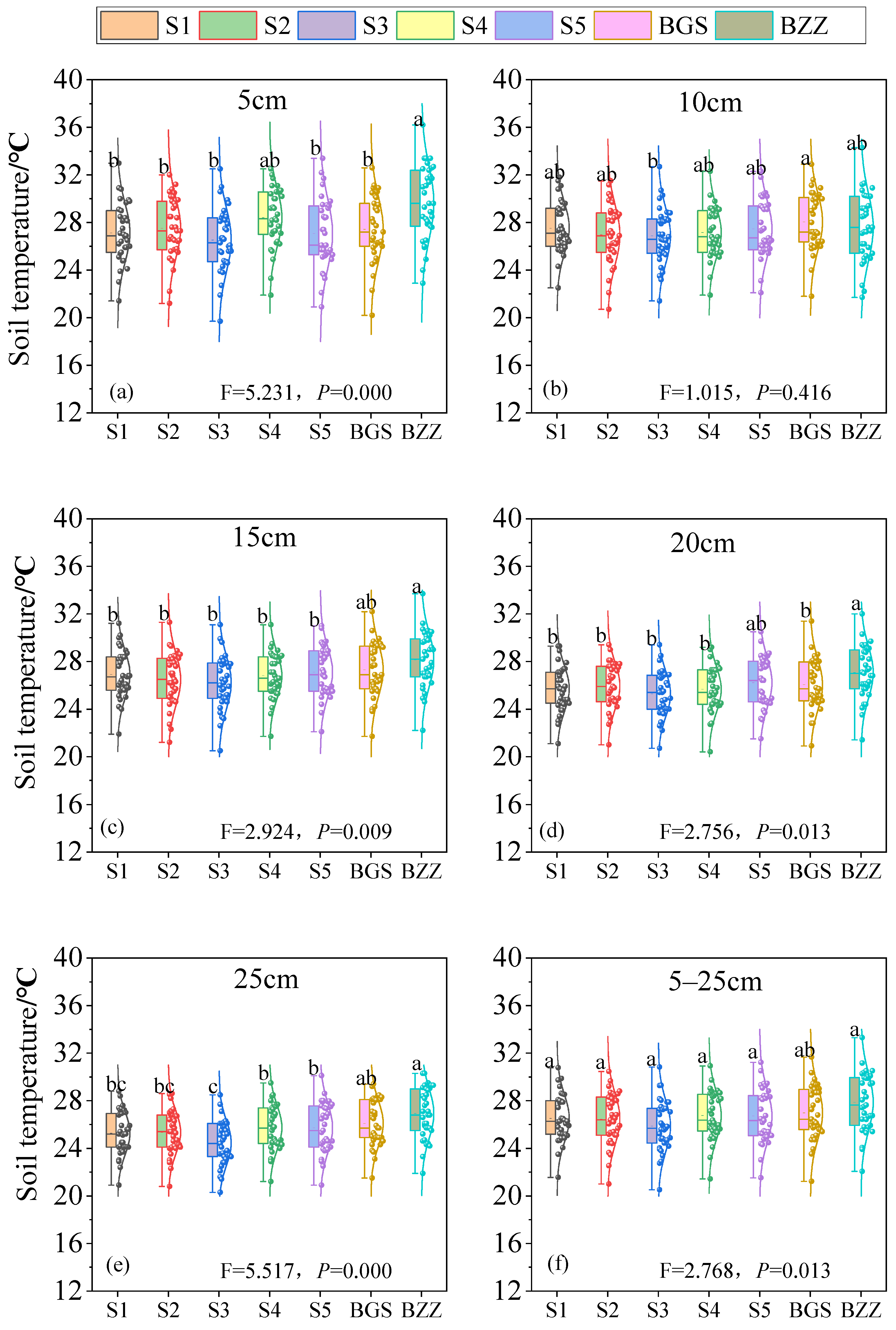
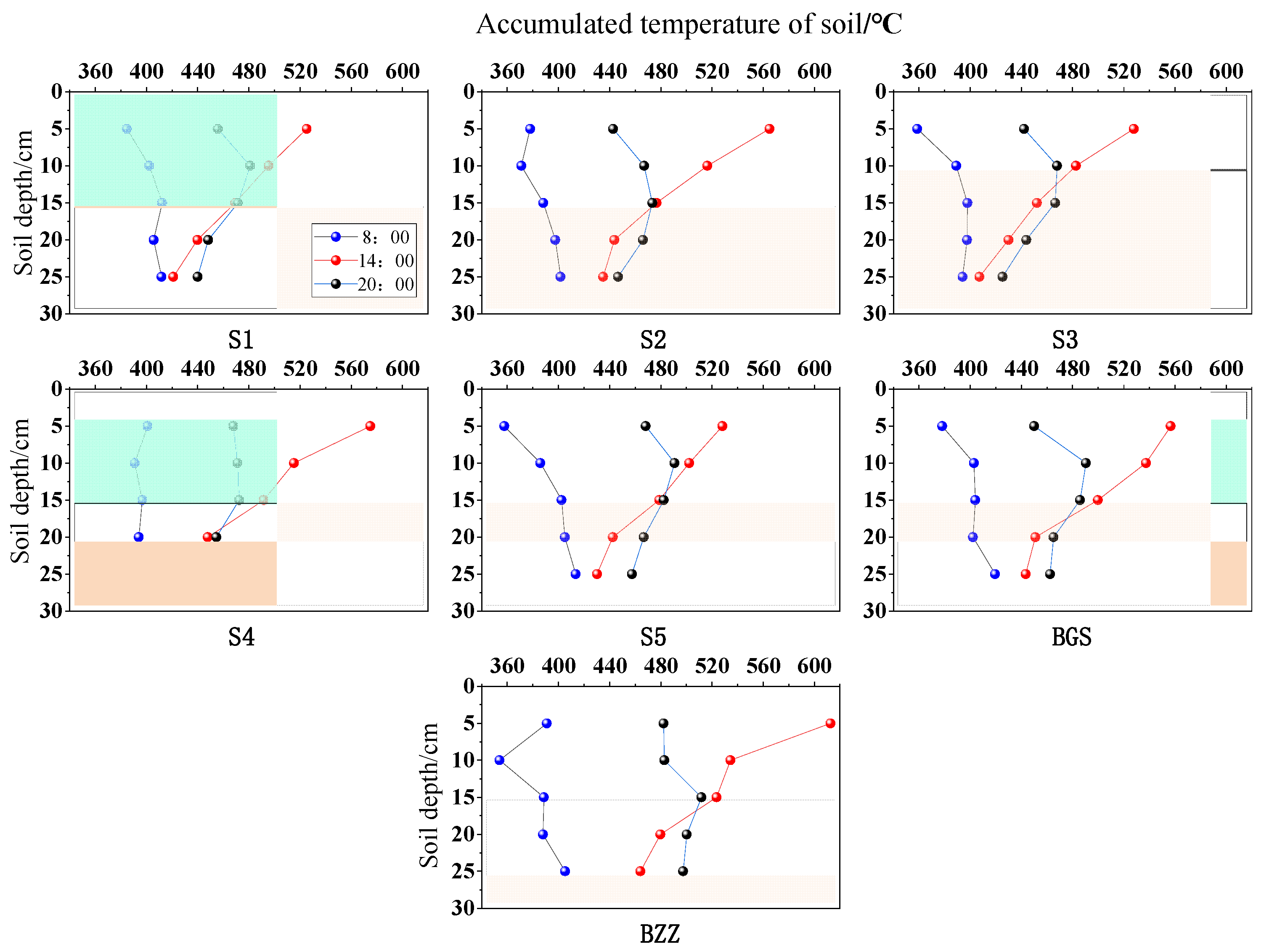
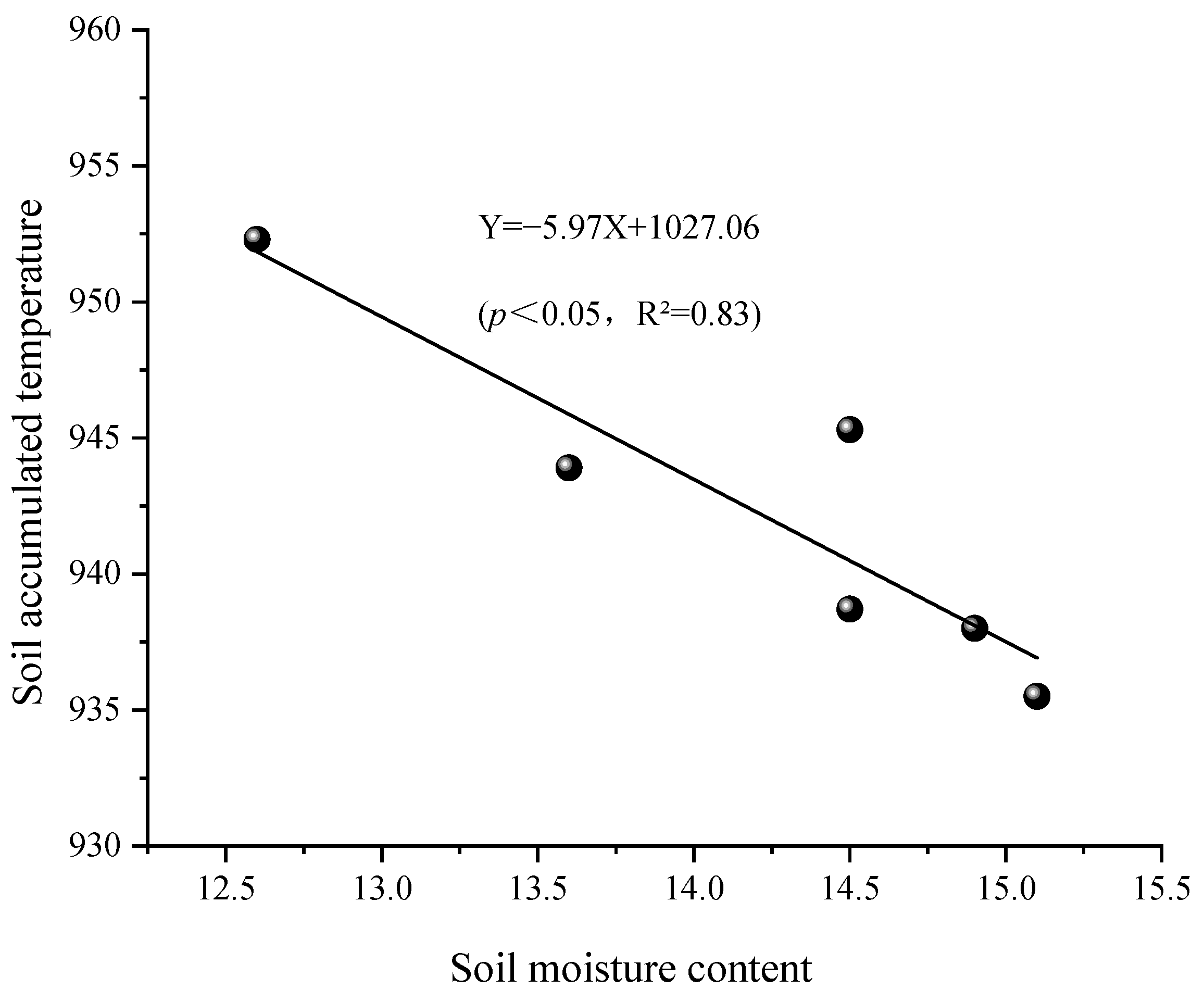
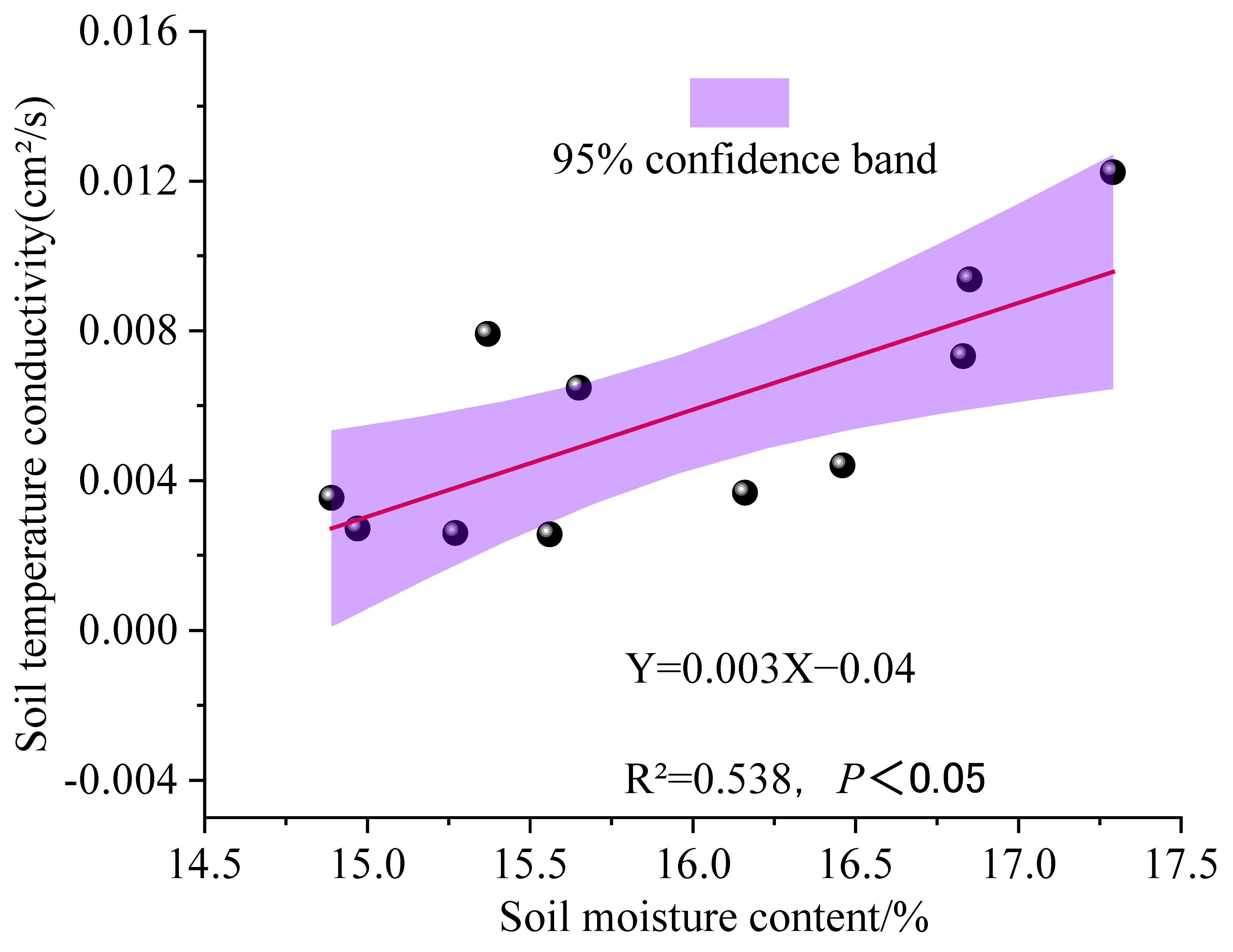
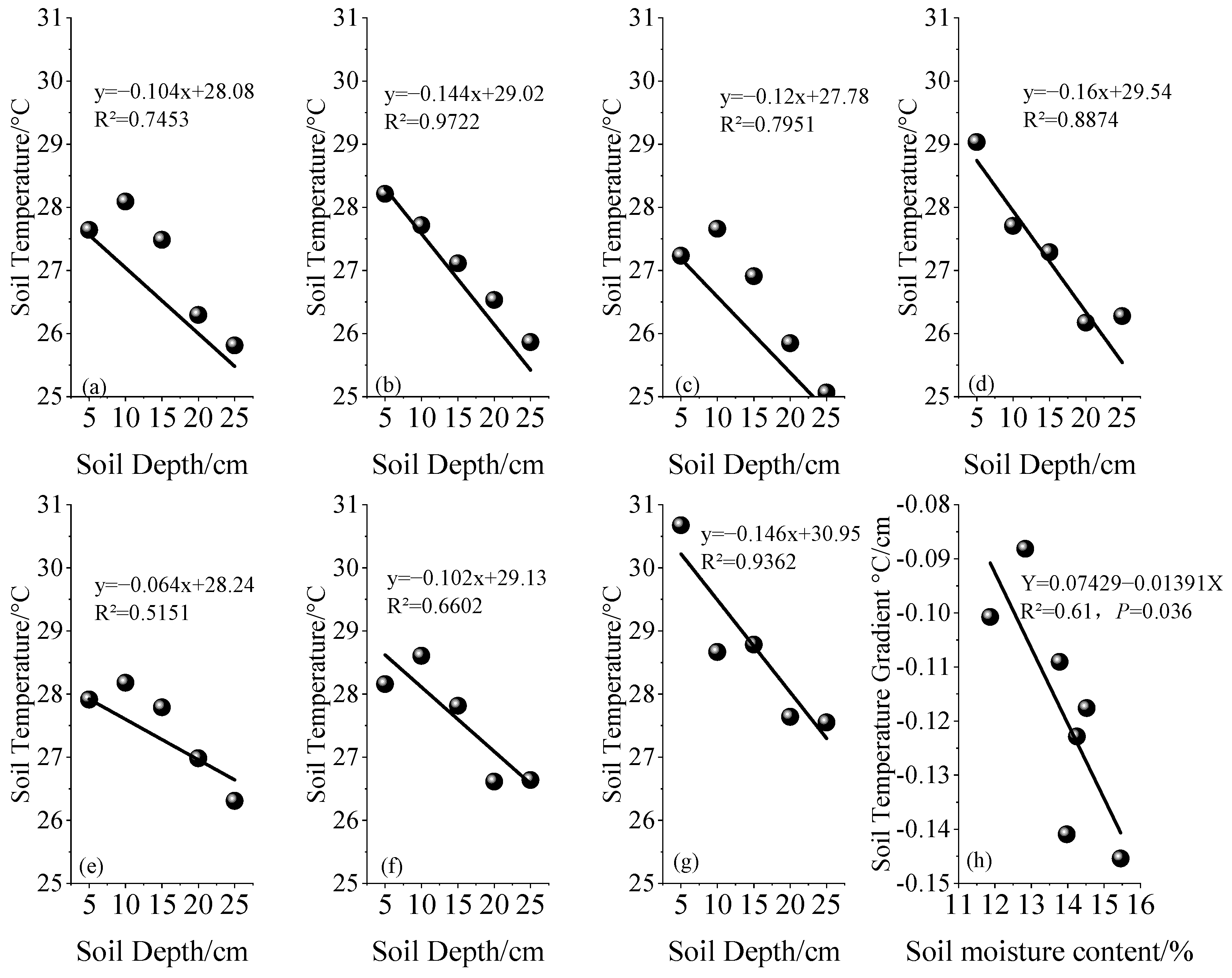


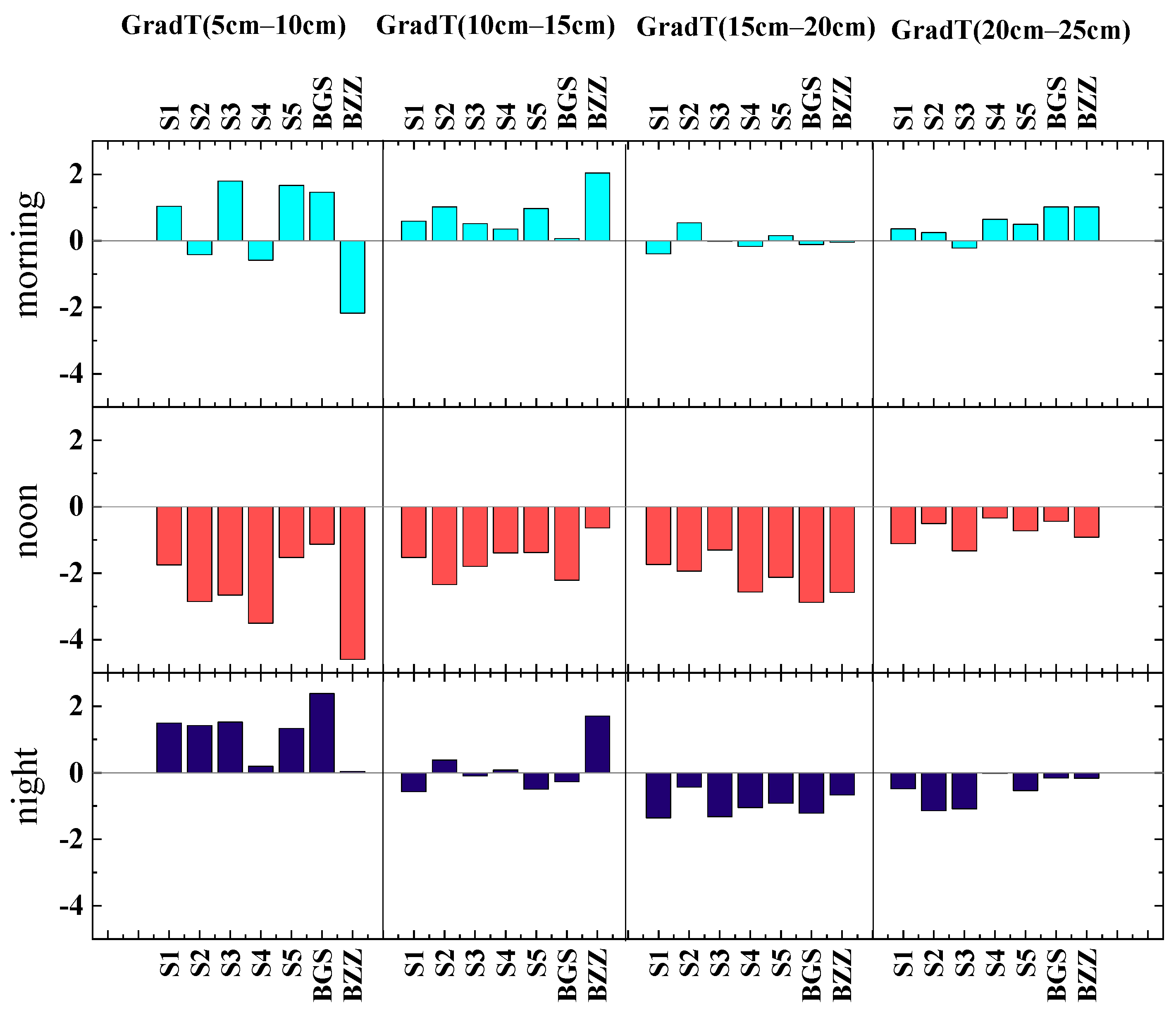

| Test Number | Description |
|---|---|
| S1 | 1050 m3 hm−2 irrigation of 1050 m3 hm−2 before sowing |
| S2 | 825 m3 hm−2 irrigation 825 m3 hm−2 before sowing |
| S3 | 600 m3 hm−2 irrigation 825 m3 hm−2 before sowing |
| S4 | 375 m3 hm−2 irrigation 825 m3 hm−2 before sowing |
| S5 | 225 m3 hm−2 irrigation 825 m3 hm−2 before sowing |
| BGS | Without irrigation |
| BZZ | Fallow and without irrigation |
| Test No. | Soil Depth /cm | Amplitude of Variation /°C | Minimum/°C | Maximum/°C | Average/°C | Skewness | Kurtosis | Coefficient of Variation/% |
|---|---|---|---|---|---|---|---|---|
| S1 | 5 | 22.1 | 16.9 | 39.0 | 27.03 | 0.44 | −0.27 | 18.22 |
| 10 | 20.1 | 18.6 | 38.7 | 27.43 | 0.23 | 0.13 | 14.14 | |
| 15 | 16.4 | 19.6 | 36.0 | 26.80 | 0.03 | 0.12 | 11.02 | |
| 20 | 15.5 | 20.0 | 35.5 | 25.63 | 0.38 | 1.23 | 9.89 | |
| 25 | 10.0 | 20.2 | 30.2 | 25.18 | −0.06 | −0.40 | 8.68 | |
| S2 | 5 | 23.5 | 16.1 | 39.6 | 27.42 | 0.52 | −0.74 | 21.72 |
| 10 | 21.5 | 16.5 | 38.0 | 26.86 | 0.01 | −0.67 | 18.14 | |
| 15 | 16.3 | 18.2 | 34.5 | 26.39 | −0.28 | −0.80 | 13.56 | |
| 20 | 12.1 | 19.0 | 31.1 | 25.85 | −0.31 | −0.61 | 10.93 | |
| 25 | 11.9 | 19.9 | 31.8 | 25.26 | 0.05 | −0.17 | 9.55 | |
| S3 | 5 | 24.5 | 15.5 | 40.0 | 26.43 | 0.45 | −0.49 | 21.25 |
| 10 | 19.6 | 18.4 | 38.0 | 26.79 | 0.25 | −0.18 | 15.01 | |
| 15 | 17.0 | 19.2 | 36.2 | 26.14 | 0.03 | 0.07 | 12.27 | |
| 20 | 12.2 | 19.9 | 32.1 | 25.19 | 0.08 | −0.28 | 9.94 | |
| 25 | 10.6 | 20.0 | 30.6 | 24.37 | 0.16 | −0.23 | 9.12 | |
| S4 | 5 | 24.1 | 16.9 | 41.0 | 28.30 | 0.51 | −0.57 | 19.82 |
| 10 | 19.7 | 17.5 | 37.2 | 27.05 | −0.04 | −0.71 | 14.99 | |
| 15 | 14.1 | 18.9 | 33.0 | 26.71 | −0.31 | −0.81 | 12.32 | |
| 20 | 14.0 | 19.0 | 33.0 | 25.55 | −0.16 | −0.38 | 10.85 | |
| 25 | 12.1 | 19.9 | 32.0 | 25.65 | −0.03 | −0.43 | 9.72 | |
| S5 | 5 | 25.7 | 15.2 | 40.9 | 26.96 | 0.29 | −0.62 | 21.32 |
| 10 | 19.8 | 17.2 | 37.0 | 27.38 | −0.03 | −0.76 | 16.45 | |
| 15 | 14.4 | 19.0 | 33.4 | 27.00 | −0.19 | −0.69 | 12.48 | |
| 20 | 14.2 | 19.2 | 33.4 | 26.11 | 0.07 | −0.45 | 11.38 | |
| 25 | 18.2 | 18.4 | 36.6 | 25.60 | 0.44 | 1.52 | 11.10 | |
| BGS | 5 | 24.6 | 15.2 | 39.8 | 27.33 | 0.43 | −0.64 | 21.79 |
| 10 | 20.2 | 18.0 | 38.2 | 27.95 | 0.00 | −0.68 | 15.99 | |
| 15 | 19.4 | 18.6 | 38.0 | 27.18 | −0.01 | −0.37 | 13.63 | |
| 20 | 18.0 | 19.0 | 37.0 | 25.94 | 0.22 | 0.72 | 11.64 | |
| 25 | 11.8 | 20.2 | 32.0 | 26.00 | 0.03 | −0.33 | 9.39 | |
| BZZ | 5 | 30.1 | 15.1 | 45.2 | 29.54 | 0.57 | −0.72 | 25.33 |
| 10 | 26.4 | 13.2 | 39.6 | 27.57 | −0.01 | −0.74 | 20.94 | |
| 15 | 21.0 | 17.0 | 38.0 | 28.06 | −0.34 | −0.84 | 16.64 | |
| 20 | 18.0 | 17.2 | 35.2 | 26.99 | −0.33 | −0.72 | 14.79 | |
| 25 | 14.4 | 18.6 | 33.0 | 26.87 | −0.38 | −0.45 | 12.53 |
Disclaimer/Publisher’s Note: The statements, opinions and data contained in all publications are solely those of the individual author(s) and contributor(s) and not of MDPI and/or the editor(s). MDPI and/or the editor(s) disclaim responsibility for any injury to people or property resulting from any ideas, methods, instructions or products referred to in the content. |
© 2025 by the authors. Licensee MDPI, Basel, Switzerland. This article is an open access article distributed under the terms and conditions of the Creative Commons Attribution (CC BY) license (https://creativecommons.org/licenses/by/4.0/).
Share and Cite
Han, G.; Tan, J.; Wang, X.; Li, H.; Shang, Q.; Tian, J. Response of Soil Temperature to Soil Moisture Content and Meteorological Elements with Gravel-Sand Mulching. Land 2025, 14, 853. https://doi.org/10.3390/land14040853
Han G, Tan J, Wang X, Li H, Shang Q, Tian J. Response of Soil Temperature to Soil Moisture Content and Meteorological Elements with Gravel-Sand Mulching. Land. 2025; 14(4):853. https://doi.org/10.3390/land14040853
Chicago/Turabian StyleHan, Gengzhe, Junli Tan, Xina Wang, Hao Li, Qian Shang, and Juncang Tian. 2025. "Response of Soil Temperature to Soil Moisture Content and Meteorological Elements with Gravel-Sand Mulching" Land 14, no. 4: 853. https://doi.org/10.3390/land14040853
APA StyleHan, G., Tan, J., Wang, X., Li, H., Shang, Q., & Tian, J. (2025). Response of Soil Temperature to Soil Moisture Content and Meteorological Elements with Gravel-Sand Mulching. Land, 14(4), 853. https://doi.org/10.3390/land14040853





